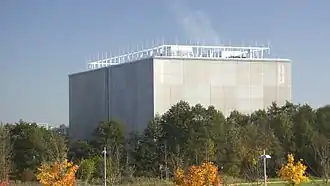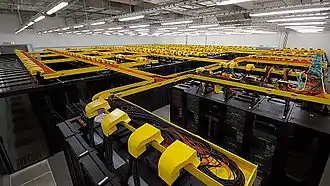SuperMUC
SuperMUC is a supercomputer of the Leibniz Supercomputing Centre (LRZ) of the Bavarian Academy of Sciences. It is housed in the LRZ's data centre in Garching near Munich.
| Operators | Leibniz-Rechenzentrum |
|---|---|
| Location | Garching, Germany |
| Architecture | 19,252 Intel Xeon CPUs |
| Operating system | SUSE Linux Enterprise Server |
| Memory | 340 TB |
| Storage | 15 PB |
| Speed | 2.90 petaFLOPS |
| Ranking | TOP500: #44, November 2017 |
| Web site | www |
History


SuperMUC (the suffix 'MUC' alludes to the IATA code of Munich's airport) is operated by the Leibniz Supercomputing Centre, a European centre for supercomputing. In order to house its hardware, the infrastructure space of the Leibniz Supercomputing Centre was more than doubled in 2012. SuperMUC was the fastest European supercomputer when it entered operation in the summer of 2012[1] and is currently ranked #20 in the Top500 list of the world's fastest supercomputers.[2] SuperMUC serves European researchers of many fields, including medicine, astrophysics, quantum chromodynamics, computational fluid dynamics, computational chemistry, life sciences, genome analysis and earth quake simulations.
Performance
SuperMUC is an IBM iDataPlex system containing 19,252 Intel Xeon Sandy Bridge-EP and Westmere-EX multi-core processors (155,656 cores), for a peak performance of about 3 PFLOPS (3 × 1015 FLOPS). It has 340 TB of main memory and 15 PB of hard disk space. It uses a new form of cooling that IBM developed, called Aquasar, that uses hot water to cool the processors. IBM claims that this design saves 40 percent of the energy normally needed to cool a comparable system.[3][4]
SuperMUC is connected to powerful visualization systems, which consist of a large 4K stereoscopic powerwall as well as a five-sided CAVE artificial virtual reality environment.
References
- "Top 500 list June 2012". TOP500.org. Retrieved 2014-12-12.
- "Top 500 list June 2015". TOP500.org. Retrieved 2015-09-30.
- "IBM builds 3 petaflop computer for Germany - SuperMUC could be world's fastest system". Pcadvisor.co.uk. 2012-09-05. Retrieved 2012-09-12.
- "IBM Newsroom - 2010-12-13 Leibniz-Rechenzentrum entscheidet sich für neuen IBM Supercomputer mit Intel® Xeon® Prozessoren der nächsten Generation für anspruchsvolle Forschungsanwendungen - Deutschland". 03.ibm.com. 2010-12-13. Retrieved 2012-09-12.
External links
| Wikimedia Commons has media related to SuperMUC. |
- "System description of SuperMUC at the LRZ website"
- Rechnen und Heizen: Neuer Supercomputer für Garching bei br-online.de, 13. Dezember 2010
- "PRACE Announces 'SuperMUC' System for LRZ"